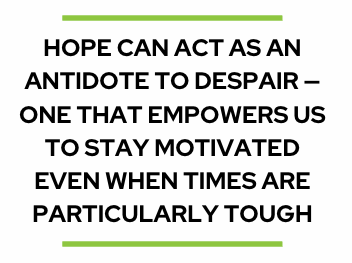- Keith Hopper

- Jul 1
- 4 min read

This essay is issue # 2 of my Engineering Hope Newsletter, where I explore practical tools and activities for fostering more hope and motivation in our work and lives. You can subscribe here.I recently had an experience that gave me a profound sense of hope - albeit in a narrow slice of my life - and I wanted to share what Hope Theory(1) has to say about this and how we might all engineer more of this kind of hope in our lives.
So here’s what happened…
I’ve been struggling on and off with knee pain for the last several years. It had gotten to the point where I stopped running entirely. Then I stumbled on some science that was new to me, suggesting there might be a different approach to managing joint pain.
The “old” approach that I had been following involved doing an activity until a joint hurts. Then you stop and rest until the pain goes away. Then you begin the activity again… until the pain returns; however, I learned that resting until pain is completely gone causes the joint, tendons and surrounding muscles to get weaker, so that when you restart the activity, pain comes on more quickly. This results in doing less and less of that activity, ultimately causing you to give up on the activity entirely for fear of pain. This appeared to be what I had been experiencing in my running.
The emerging science suggests doing almost the opposite from what I had been doing. Once any severe pain reduces, you are urged to put progressive load on joints (rather than protect joints from load), extend the range of motion (rather than limit it) and use pain monitoring rather than pain avoidance to regulate strengthening and exercise. Then, as old activities are picked up, we find ourselves being able to do more and more over time without pain, rather than less and less.

OK, this is a long winded explanation, but I wanted you to get a sense of the hope that emerged for me when I learned of this new approach.
I wondered - what exactly was behind my sense of hope here, and is it repeatable?
Hope Theory suggests that hope comes from a combination of three things: goals (what we want) combined with agency (what we feel capable of) along with pathways (a clear way to get there).

What I had stumbled on is that hope sometimes reveals itself not when we deliberately start with a goal and try to tackle it, but when we become aware of a novel way of getting something done (a pathway) for the first time. If this pathway is appealing, then we’re able to connect it to a latent or abandoned goal. At this point, if we believe that we’re capable of following this pathway (agency), we’ve achieved the third part of Hope Theory.

In the case of my knee, I had given up on running until I was exposed to a new pathway (progressive joint loading) which revealed a goal I wanted (to run again) and believed was possible (seeing and experiencing myself actually doing it)!
The more I looked at this “Pathways First” model, the more I saw it everywhere. Here’s a partial list of where I’ve found this type of hope in my life and how each might work to bring hope:
Novel solutions: Like progressively loading our joints, solutions we hadn’t previously considered can give us hope that addressing tough problems is, in fact, possible. In fact, building a habit of focusing on positive solutions can be an antidote to hopelessness.
Cognitive reframing: Being exposed to a new perspective or concept can help us see the world differently and open ourselves to creating new pathways. Consider how TED talks that share an inspiring new idea can motivate us to take action.
Social inspiration: When someone like us has success, it’s easier to see ourselves in their shoes. Thoughts like “If they can do that, why can’t I?” can give us hope by understanding their pathway and recognizing we’re also capable.
New found resources: When we’re lucky enough to get access to resources like money or tools, we can ask ourselves what we might do with this new tool or resource, and our imagination reveals new pathways towards achieving our goals.
Exposed opportunities: Sometimes an opportunity is shared with us that we didn’t previously know about or recognize, and these moments can give us a sense of hope based on this new path forward. Think: a job posting, an inspiring class, or someone asking for help.
Novel environments: A trip somewhere new can break us out of our current ruts and expose us to different ways of life and different paths to success.
Has a “Pathways First” moment happened to you? I’d love to hear from you if it has, since hearing what others have discovered is itself a new pathway to hope.
(1) Hope Theory - coined by Charles R. Snyder in 1991, differentiates hope from optimism, and has empirically determined the components (goals, pathways, and agency) that when present in an individual, create a sense of hope for the future.





